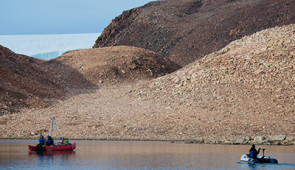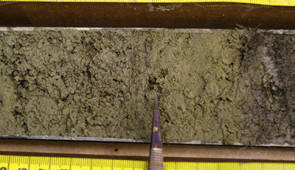
Ancient plant wax reveals how global warming affects methane in Arctic lakes
Warming led to an intensified methane cycle, lasting thousands of years, study finds
- Link to: Northwestern Now Story
EMBARGOED UNTIL 2 P.M. EDT (U.S.) ON FRIDAY, SEPTEMBER 29, 2023
- New study makes novel use of plant biomarkers preserved in sediment to reconstruct methane cycling over the past 10,000 years
- As planet warmed due to slow changes in Earth’s orbit, lakes produced increased amounts of methane, which is a potent greenhouse gas
- Plant waxes hold an isotopic signature of ancient methane
- Researcher: ‘Living on a warming planet, we can look to these signs from the past to predict our future’
EVANSTON, Ill. — By studying fossils from ancient aquatic plants, Northwestern University and University of Wyoming (UW) researchers are gaining a better understanding of how methane produced in Arctic lakes might affect — and be affected by — climate change.
In a new study, the researchers examined the waxy coatings of leaves preserved as organic molecules within sediment from the early-to-middle Holocene, a period of intense warming that occurred due to slow changes in Earth’s orbit 11,700 to 4,200 years ago. These wax biomarkers — which were once a part of common aquatic brown mosses — were preserved in sediment buried beneath four lakes in Greenland.
By studying these biomarkers, the researchers discovered that past warming during the middle Holocene caused lakes across a wide range of Greenland’s climates to generate methane. Because methane is a more potent greenhouse gas than carbon dioxide, any changes in methane production with warming are important to understand.
Currently, researchers have incomplete knowledge of how much methane is produced in Arctic lakes and how ongoing warming will affect methane production. The new study suggests that warming potentially could lead to a previously under-appreciated flux in methane emissions from lakes.
The study was published today (Sept. 29) in the journal Science Advances.
“Last time Greenland lakes experienced major warming, we were coming out of the last ice age, and it took some time for the conditions to develop for lake methane cycling to increase,” said Jamie McFarlin, who led the study. “But once it developed, the lakes in our study maintained an intensified methane cycle for thousands of years until the onset of the naturally driven late Holocene cooling. This supports a climate dependence on lake methane cycling in some Arctic lakes.”
“These data show increased periods of methane cycling during past warm periods,” added Magdalena Osburn, the study’s senior author. “Living on a warming planet, we can look to these signs from the past to help predict our future. We suspect this process is going to become more and more important in the future of these lakes.”
When the research began, McFarlin was a Ph.D. student at Northwestern; now she is an assistant professor at UW. Osburn is an associate professor of Earth and planetary sciences at Northwestern’s Weinberg College of Arts and Sciences. Osburn co-advised McFarlin with Yarrow Axford, William Deering Professor in Geological Sciences at Weinberg College and the paper’s second author.
Lakes act as significant natural sources of methane, but exactly how much methane production will change with ongoing warming within Arctic lakes is not fully quantified. And because Arctic and boreal landscapes are the fastest warming regions on Earth, it is imperative for researchers to better understand the dynamics between warming temperatures and methane production in these lakes.
To explore these dynamics, the researchers produced new data at two lakes (Wax Lips Lake and Trifna Sø) and reviewed published data from two additional lakes on Greenland (Lake N3 and Pluto Lake). They compared the hydrogen isotopic composition of aquatic plant waxes within the sediment to biomarkers from terrestrial plants and other sources. The isotopic composition of biomarkers from aquatic plants revealed a signature from methane during the early-middle Holocene at most sites.
Because these plants absorb methane, they might mitigate some of the methane produced in lakes before it is emitted into the atmosphere.
“In the lakes in our study, some methane was taken up by aquatic mosses living in the lakes — likely through a symbiotic association with a type of bacteria that eats methane,” McFarlin said. “We do not know yet how much methane was produced versus consumed in these lakes during the time period of our study, so the overall effect on the atmosphere remains unclear. The uptake of methane into plants is likely restricted to very specific types of aquatic mosses, however, so not all lakes or even all Arctic lakes will have these same dynamics.”
“The Arctic has huge areas covered in lakes,” Axford said. “Not every lake has mosses that will record methane dynamics, but our study also highlights that those vast swaths of Arctic lakes are vulnerable to climate-driven changes in methane cycling, whether mosses are on site to witness those changes or not. This is yet another way that rapid warming in the Arctic could affect global climate.”
The study, “Aquatic plant wax hydrogen and carbon isotopes in Greenland lakes record shifts in methane cycling during past Holocene warming,” was supported by the National Science Foundation (NSF) Division of Polar Program awards, an NSF Graduate Research Fellowship, Northwestern’s Paula M. Trienens Institute for Sustainability and Energy and a Geological Society of America Graduate Research Award.
Multimedia Downloads
Field work photos
Interview the Experts



